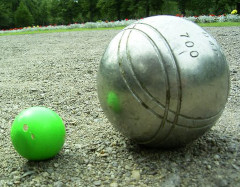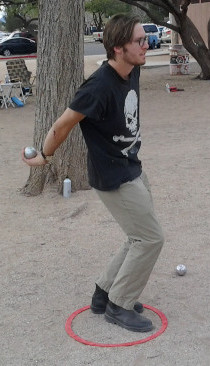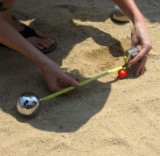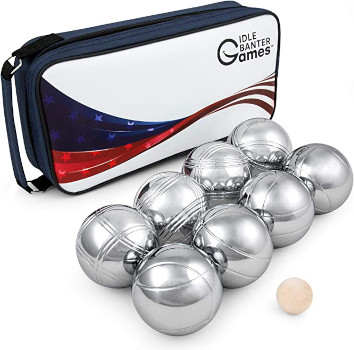Game Rules of Petanque
Composition and rules of the game
In a Nutshell
Prerequisites

- Two teams of one, two (doubles), or three players (triples)
- Three balls for each player, or two when playing in triples
- A little wooden target ball called the cochonnet or jack
- A flat, open area to play on — ideally with a hard surface (e.g. thin gravel)
Starting a Round
- A coin toss decides which team starts the first round
- A player from the starting team draws a circle on the ground, thereby delimiting the zone from which players can throw their balls
- The player that drew the circle steps into the circle and throws the jack
- A player from the starting team then throws the first ball, as close as possible to the jack
Principle
- The ball nearest to the jack is said to be holding the point
- The players in the team that is not holding the point throw their balls until they place a ball closer to the jack
- The round continues in this fashion until one of the teams has run out of balls
- The other team then ends the round by throwing their remaining balls
Scoring System
- The team whose best ball is closest to the jack at the end of the round, wins the round
- The winning team gets one point for each of their balls that is closer to the jack than the losing team’s closest ball
- The losing team doesn't score any points
Next round
- A game of petanque constitutes multiple rounds
- A player from the team that won the previous round, throws the jack from a new circle drawn around the jack’s last position — thereby starting a new round
- The winner of the game is the first team to reach 13 points
More detailed
Throughout the years, a general consensus has been established on the details of the game rules of petanque. The game rules below are based on the official game rules as specified by the FIPJP.
The petanque set and its official dimensions
Petanque is played with hollow metal balls that have a diameter between 7.05 cm (2.78 inch) and 8 cm (3.15 inch), and a weight between 650 grams (22.93 ounce) and 800 grams (28.22 ounce).
Jacks are made of wood or an FIPJP approved synthetic material. Their diameter should be 30 mm (1.19 inch), and their weight between 10 (0.35 ounce) and 18 grams (0.67 ounce). Unlike the balls, it should be impossible to pick up the jack with a magnet.
Terrain
Although petanque can be played on any surface, it usually takes place on a designated terrain — typically marked with nails and string. This terrain should then be minimum 12 metres (13.12 yards) long and 3 metres (3.28 yards) wide.
A ball or jack on the outside of the boundary of the terrain is considered to be out-of-bounds and dead.
Team composition
Petanque is a sport in which 2 teams play against each other. It should be played in triples, doubles or singles.
- Triples 3 players against 3 players | 2 balls per player
- Doubles 2 players against 2 players | 3 balls per player
- Singles 1 player against 1 player | 3 balls per player
Multiple rounds
There are multiple rounds in a game of petanque. In each round, the winner of that round earns points. A game is won by the first team that gathers 13 points.
Starting the first round
The players must draw lots (toss a coin) to decide which team will be the first to throw the jack. A member of the team that won the toss chooses the starting point and places or draws a circle on the ground. This circle delimits the zone from which players can throw the jack and balls.
Throwing zone

The players' feet must be entirely on the inside of the circle and they must not leave it or be lifted completely off the ground until the thrown ball has touched the ground.
Throwing the jack
The team that won the toss will have one attempt to throw the jack. If this jack is not valid, it is handed to the opponent, who must place — not throw — it on the terrain at a valid position.
For the jack to be in a valid position, it must be:
- at a distance between 6 metres (6.56 yards) and 10 metres (10.94 yards) from the internal edge of the circle
- at a distance of minimum 50 cm (19.69 inch) from any obstacle
- visible to an upright standing player from within the circle
Throwing the balls
Once the jack is in a valid position, a member of the team that won the toss throws the first ball as close as possible to the jack. There are no rules in regards to the throwing (or rolling) technique.
If the first ball goes out-of-bounds, the other team gets a chance to throw the first ball and vice versa, until a team manages to get a ball on the designated terrain. This ball is now the only ball on the terrain, and therefore nearest to the jack.
From this point on, the ball nearest to the jack is said to be holding the point. The team that is not holding the point throw their balls until they place a ball closer to the jack, thereby triggering the other team to throw their balls until they are again holding the point, and so on.
When one of the teams has thrown all its balls, the other team ends the round by throwing its remaining balls. The team whose best ball is closest to the jack at the end of the round, wins the round.
Measuring the points

The measuring of points is the responsibility of the team that threw the last ball of the round. The other team has the right to double-check these measurements.
Next rounds
A game of petanque is ended and won by the first team that gathers at least 13 points over a series of rounds.
In the rounds succeeding the first one, the circle delimiting the throwing zone is placed or drawn around the point where the jack finished at the previous round. The jack and the first ball are thrown by the team that was the last to score points — as if they won the toss in the first round.
Exceptional situations
Dead jack
The jack is dead when it is displaced outside of the designated terrain. Or if it’s not visible from within the circle — with the exception of it being masked by a ball. A dead jack marks the end of the round.
If the jack is dead, and only one team has balls left to play, that team scores as many points as balls that remain to be played. Otherwise the round is invalid and restarted.
No team holds the point
This situation can occur when there are no balls left on the designated terrain. Or when the two closest balls to the jack belong to the opposing teams, and are at an equal distance from it.
If at this moment both teams still have balls, then both teams — starting with the team that played last — must take turns in throwing balls until one of them holds the point.
If only one team has balls left to play, they just play them. If no team has balls left to play, and no team holds the point, the round is invalid and restarted.
Where to Buy?

If you're looking to buy a petanque set, we recommend the one featured on Amazon.
It’s the most affordable option that still meets official FIPJP standards for size and weight — great if you’re just getting into petanque or want to get started with an affordable set.
Heads up: the following link is an affiliate link. If you take action (i.e. make a purchase) after clicking it, we'll earn some coffee money. You do not pay a higher price.
view on amazon.com



